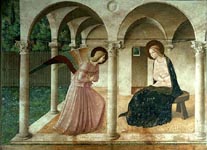Guido di Pietro Trosini, known as Beato Angelico, was born in Vicchio Mugello between 1395 and 1400. Nothing is known about his training and his early works are lost; he was a miniaturist as well as a painter and he is the author of the Madonna dei Domenicani del Messale, number 558 in St Mark’s Museum. Among his early works there are (possibly) the Triptych of St Peter martyr and the Madonna with Child and saints, both in the museum of St Mark in Florence.
Full lighting and delicate use of colours are typical of Angelico’s work; during his early years as an artist he was inspired by Masaccio’s art (evident in the picture Naming of the Baptist). He was also inspired by older painting styles and probably switched between the two styles depending on the paintings he received a commission for. The secret of his art is probably in this balance between past and present.
 Before painting the frescos in the convent of St Mark in Florence (1438-1446), Beato Angelico painted some of his masterpieces: the Crowning (now in the Louvre), the Deposition of St Trinity and the Triptych of Perugia (today in the museum of St Mark). In the Crowning a series of human figures are kneeling before a staircase; at the top of the staircase the crowning ceremony is taking place. Some of the figures are turned away from the observer and thus give depth to the picture. This was quite a novelty at the time. Before him only Masaccio, in painting the Crucifixion, had painted Magdalene turned away from the observer.
Before painting the frescos in the convent of St Mark in Florence (1438-1446), Beato Angelico painted some of his masterpieces: the Crowning (now in the Louvre), the Deposition of St Trinity and the Triptych of Perugia (today in the museum of St Mark). In the Crowning a series of human figures are kneeling before a staircase; at the top of the staircase the crowning ceremony is taking place. Some of the figures are turned away from the observer and thus give depth to the picture. This was quite a novelty at the time. Before him only Masaccio, in painting the Crucifixion, had painted Magdalene turned away from the observer.
In the Deposition of St Trinity, despite the gothic frame, he drew a landscape in which he placed his figures in a balanced and carefully studied arrangement. There is a city with walls in the background, possibly the town of Cortona.
In the platform of the Triptych of Perugia (1437) there are some of the most beautiful scenes drawn by the artist, such as Birth and Calling of the Saint, where the artist’s pleasure in story telling and fantasy tales is clear.
Between 1438 and 1446 he paintedfrescos in the convent of St Mark, which started a new phase in the development of his painting style. This style was more austere; the atmosphere of his paintings is mystic, an effect he achieved by using simple compositions. An example is his work the Last Judgement. The frescos in the convent include: the Crucifix, the Transfiguration and St Dominic (in the cloister) and the beautiful Annunciation, at the dormitory’s entry.
The atmosphere of this painting is serene, quiet, sweet; the angel and the Virgin are in a portico (which resembles the convent’s portico). Masaccio’s realism is missing here and divine contemplation is the main theme instead of worldly matters.
The artist was in Rome in 1446. He painted a chapel in the Vatican for Pope Eugene IV (perished). In Orvieto he began decorating the chapel of St Brizio in the Duomo. He was called back to Rome where he decorated the Niccolina chapel for Pope Niccolò V. He painted the Tales of St Stephen and St Lawrence. Before 1449 he painted the doors of the wardrobes in the Santissima Annunziata (now in the museum of St Mark). Beato Angelico died in Rome in 1455.